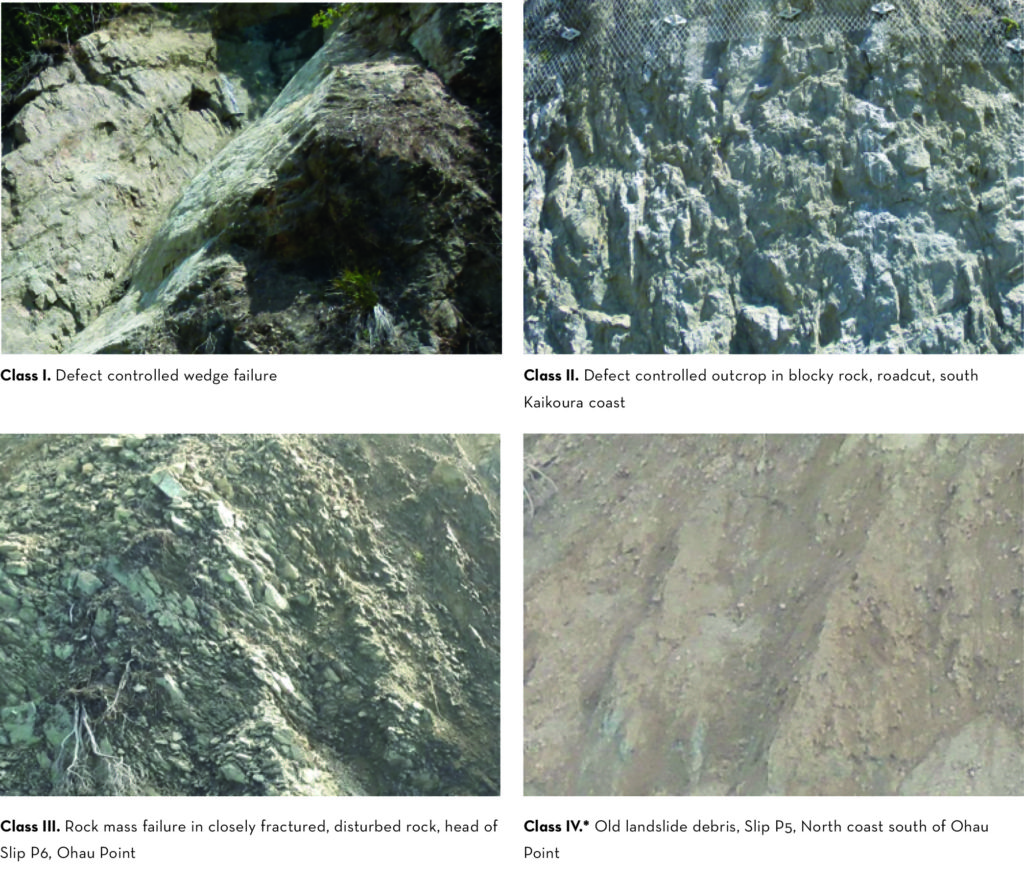The North Canterbury Transport Infrastructure Recovery (NCTIR) has been set-up by the government under the Hurunui/Kaikoura Earthquakes Recovery Act 2016. Its purpose is to repair and re-open the earthquake-damaged road and rail networks between Christchurch and Picton by the end of 2017. This includes the Kaikoura Coast and the inland road (SH70). NCTIR is an alliance partnership between the NZ Transport Agency, KiwiRail, Fulton Hogan, Downer, HEB Construction and Higgins.
In this contribution we present the rock mass classification system adopted for use by the NCTIR geotechnical team when selecting design and construction solutions for slope failures caused by the Kaikoura earthquake.
Many rock mass classification systems have been developed in the past 100 years, initially for tunnel design. The two most widely accepted systems are the Geomechanics classification scheme, RMR (Bieniawski, 1973) and the rock quality index, Q (Barton et al. 1974). Terzaghi (1946), Wickham et al. (1972) and Palmstrom (1996), among others, have also proposed classification systems for underground works. Most of these systems have significant shortcomings when applied to rock slope stability. In particular, they do not specifically consider triggering factors (such as earthquakes or rainfall), and groundwater is not taken into account as a trigger for failure.
Many researchers have attempted to address these shortcomings. A geomechanical classification for slopes, Slope Mass Rating (SMR), was introduced by Romano in 1985. The SMR system provides adjustment factors, field guidelines and recommendations on support methods for slopes. However, this system also proved to have limitations in closely jointed rock masses and large-scale rock slopes.
More recently, the Slope Stability Rating (SSR), based on the widely used Geological Strength Index (GSI; Hoek et al, 2002), has been developed for assessing the stability of non-structurally controlled failures in fractured rock slopes (Taheri & Tani, 2010) and for the design of cut slopes in rock (Taheri 2012). SSR considers five additional parameters: uniaxial compressive strength of the intact rock, rock type (lithology), slope excavation method, groundwater condition and earthquake force.
The fundamental problem with all of these systems is that they do not readily apply to the Upper Paleozoic to Mesozoic-age greywacke that is widespread throughout New Zealand. Comprising strong sandstones, interbedded sandstones and weak mudstones, and mudstones, these rocks are typically closely-jointed and commonly tectonically disturbed, and have an unusual combination of joints with low persistence but very high intact rock strength (unweathered, intact greywacke sandstones commonly have unconfined compressive strengths above 100 MPa).
The classification system shown below is only intended for use by NCTIR. It is based on the descriptive elements of GSI (rock mass structures) but recognises the unique characteristics of the greywacke and the ways in which the slopes along the Kaikoura coast have failed so that in addition to true rock slopes there are many slopes mantled with colluvium and/or landslide debris. These are equally important in identifying and addressing potential slope hazards and remedial options for the road and rail links along the coast.


Figure 1: Rock mass classification for selection of design options for Kaikoura Coast slopes
The proposed rock classes are outlined below. Figure 1 relates them to the GSI chart and table given in Read et al (2000, their Figure 2 and Table 2):
Class I. Blocky rockmass. Stability controlled by persistent defects (wedges, plane failures, topple). Sluice/scale if necessary. Further treat at source (bolts, anchors, mesh)
Class II. Blocky/disturbed mass. Failure may be governed by defects (broken/dilated rock slides off underlying less disturbed/less relaxed rock) or may be governed by rock mass strength. Sluice/scale affected parts of the slope. Install additional protection on slope (mesh, drape) or at base of slope (bund, fence, catch ditch) as appropriate
Class III. Disturbed to disintegrated rockmass. Failure governed by rock mass strength. Sluice/scale affected parts of the slope. Install additional protection on slope (mesh, drape) or at base of slope (bund, fence, catch ditch) as appropriate
Class IV. Colluvium/landslide debris/talus. Inherently unstable if oversteepened (undercut); erodible under moderate to high precipitation. Remove where practicable; protect assets at base of slope (bunds, catch ditches).
Class V. NOT USED. Rock class only occurs in small area(s). Behaviour can be covered by other classes.

Figure 2: Sample photographs of rock mass classes for Kaikoura Coast slopes. *Class IV is the failed version of Classes I to III
Conclusion
While very simplistic, this classification scheme has proved itself useful for its intended purpose.
References
Bieniawski, Z.T. 1973. Engineering classification of jointed rock masses. Trans S. Afr. Inst. Civ. Engrs 15, pp335-344.
Barton, N.R.; Lien, R.; Lunde, J. (1974). Engineering classification of rock masses for the design of tunnel support. Rock Mechanics and Rock Engineering 6 (4): 189–236
Hoek E, Caranza-Torres CT, Corcum B (2002) Hoek–Brown failure criterion- 2002 edition. In: Bawden HRW, Curran J, Telsenicki M (eds) Proceedings of the North American Rock Mechanics Society (NARMS-TAC 2002). Mining Innovation and Technology, Toronto, pp 267–273
Palmstrom, A. (1996). Characterizing rock masses by the Rmi for use in practical rock engineering, part 1. Tunnelling and Underground Space Technology 11(2) 175-188
Read, S.A.L.; Richards, L.; Perrin, N.D. (2000). Assessment of New Zealand greywacke rock masses with the Hoek-Brown failure criterion. GeoEng 2000, Melbourne, Paper 0868
Romana, M. (1985). New adjustment ratings for the application of Bieniawski classification to slopes. In Proc. Int. Symposium on the Role of Rock Mech, pp49-53
Taheri, A. & Tani, K. (2010). Assessment of the Stability of Rock Slopes by the Slope Stability Rating Classification System. Rock Mech Rock Eng 43: pp321-333. doi:10.1007/s00603-009-0050-4
Taheri, A. (2012). Design of rock slopes using SSR classification system. International Conference on Ground Improvement and Ground Control, Wollongong, Australia.
Terzaghi, K. (1946). Rock defects and loads on tunnel supports. In Proctor, R.V.; White, T. Rock Tunnelling with Steel Supports. Youngstown, Ohio: pp. 15–99
Wickham, G.E., Tiedemann, H.R. and Skinner, E.H. 1972. Support determination based on geologic predictions. In Proc. North American rapid excav. tunneling conf., Chicago, (eds K.S. Lane and L.A. Garfield), 43-64. New York: Soc. Min. Engrs, Am. Inst. Min. Metall. Petrolm Engrs.
